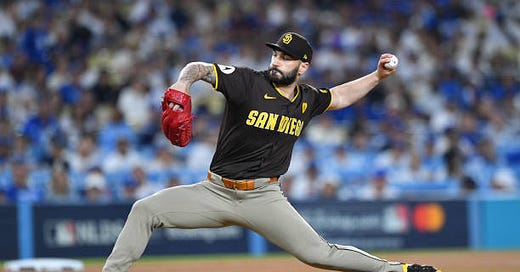Photo Credit: Icon Sportswire (Getty Images)
There is a lot to be optimistic about if you are a Boston Red Sox fan. While we were fed the “full throttle” quote and clung to that last winter, this winter feels different. The Red Sox met with Juan Soto and the three hour presentation they put together went well. Sam Kennedy finally spoke and the front office seems to have shifted a gear.
“Even if it takes us over the CBT,” said Kennedy, referring to the first threshold of the competitive balance tax that stands at $241 million next year. “Our priority is 90 to 95 wins, and winning the American League East, and winning the division for multiple years.”
That is much different than full throttle. That sounds like a front office that has a sense of urgency and a plan. They have also been talking to starting pitchers in Max Fried and Blake Snell. Needless to say, they are big game hunting and are not shy to being in the mix. Pitching is going to be the primary focus, especially for a frontline starter. However, they need relief pitching to address the back of the bullpen. One name they need to circle and make a run at is Tanner Scott.
Scott is the Real Deal
Scott is a player that’s pitched for three different organizations. He was originally drafted by the Baltimore Orioles, where he posted a 4.73 ERA and a 1.54 WHIP across 5 seasons and 156 innings pitched. Scott was always a high strikeout guy, averaging a 12.0 K/9 in his tenure with Baltimore. The ERA was concerning but the stuff was always there prior to being traded to the Miami Marlins.
Things took a brighter turn in his short stint with the Marlins. His ERA was lowered to 2.73 and the WHIP as well to 1.20. His ability to strikeout guys at a high rate remained intact and he was a much improved pitcher. Then, he became the hottest commodity at the trade deadline and moved to the San Diego Padres.
Scott was an enormous asset to the back of the Padres bullpen. Not only did he help close games, but he pitched in all kinds of high leverage situations. On the average leverage index, Scott averaged 1.97, which is high. If the top of the order was coming, Scott was ready. Not only did he pitch in those situations, he thrived. Scott racked up four saves and a 2.73 ERA with the Padres.
Scott is the type of pitcher every team wants at the back end of the bullpen. Limiting contact (92nd percentile in whiff rate) limits the amount of big innings teams can have in the later innings. Like many pitchers who have elite strikeout numbers, Scott does struggle with walks. Although Scott gets opposing hitters to chase 31.9% of the time, he walks hitters 12.2% of the time. Scott’s walk rate ranked in the 7th percentile. While Scott may be elite at limiting contact, free passes late in games seem to always come back to haunt pitchers. How long can Scott continue to find success if his walk rate remains the same?
Scott relies heavily on his 4-seam fastball and his slider. His fastball was essentially untouchable, having just a .134 batting average against. He’d mix in his slider, which was his best put away pitch. This is the type of pitcher the Red Sox need as they do not have a legitimate lefty in their pen or a legitimate closer.
Red Sox Bullpen Was Leaky
The Red Sox bullpen finished with a 4.39 ERA (24th overall) and with a 1.34 WHIP (25th overall). At times during the year they showed flashes of promise, but in the end it proved to be leaky. Only one team had more meltdowns than the Red Sox and that was the Chicago White Sox, who became the worst team in the history of the sport. When the games really mattered, the Red Sox couldn’t hold the lead. They had the most blown saves of any bullpen after the All-Star break and the worst ERA.
The biggest reason for those meltdowns was the gaping hole in the back of their bullpen. Legendary closer Kenley Jansen and Chris Martin dealt with injuries down the stretch. Deadline acquisitions Lucas Sims and Luis Garcia were bad. When a team’s back of the bullpen is depleted and faltering, the rest of the bullpen is doomed.
Now, future Hall of Fame closer Kenley Jansen and set up man Chris Martin are free agents along with Sims and Garcia. The Red Sox are losing two extremely valuable assets in the back of the bullpen. When the game was close or it was a high leverage situation, those two were always called upon. Jansen in particular thrived in the high leverage situations. On the average leverage index, Jansen had a 1.88 when entering the game, which was the 5th highest among qualified relievers. Other than staying healthy, Jansen and Martin were dependable and held the lead the majority of the time.
Looking toward next season, could Justin Slaten be ready for the closer role? Possibly. However, Alex Cora needs more than one arm in the back of the pen and a more proven commodity. That’s where Scott comes into play. If CBO Craig Breslow can convince Scott to come to Boston, he would be the leader of a group that consists of Slaten, Liam Hendriks, and hopefully Garrett Whitlock. Over the years, Red Sox fans have seen the advantages of having an elite closer and the disadvantages of not having an elite closer.
Give Scott a Call
Giving Scott a call is a no-brainer decision. He is a relief pitcher that fits a need and is the type of pitcher that adds an element that’s currently missing. Everyone knows it, but more importantly the front office knows it. Sam Kennedy made that perfectly clear during his press conference:
“Look, we have to add, and that’s what we’re trying to do, but I think we’re in a good position to add right now,” Kennedy said. “We need more pitching, front of the rotation guys and bullpen. We feel good about our positional core, we really do. A high priority is pitching but everything and anything’s on the table for us — free agency, trades, promotions from the minor leagues.”
The Red Sox need pitching they can rely on in high leverage situations. They need back of the bullpen help and Scott would be a tremendous addition to the staff. The only thing that’s left for the front office is to go out and get it done.






